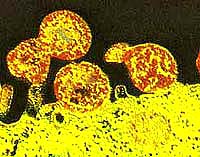Chlamydia is a real threat to human health. There are diseases of the urinary apparatus, the conjunctivities of the eyes, joints, respiratory organs, the pathology of pregnancy and disease of other internal organs.
Content
 Scientists opened chlamydia relatively recently - in the early 80s. Of the four types of these microorganisms known today, only one can cause chlamydia - an infectious disease transmitting predominantly sexually. However, there are other ways of infection, for example, the real danger of the transfer of infection to a child from a patient of a mother, intrauterine way or during childbirth. Household infection - quite rare case. Nevertheless, chlamydia can get into the body through general hygiene objects: washcloths, towels, since in the water environment chlamydia is saved sufficiently long.
Scientists opened chlamydia relatively recently - in the early 80s. Of the four types of these microorganisms known today, only one can cause chlamydia - an infectious disease transmitting predominantly sexually. However, there are other ways of infection, for example, the real danger of the transfer of infection to a child from a patient of a mother, intrauterine way or during childbirth. Household infection - quite rare case. Nevertheless, chlamydia can get into the body through general hygiene objects: washcloths, towels, since in the water environment chlamydia is saved sufficiently long.
More often, children are infected more often, especially in families, where this disease suffers from at least one of the adults.
Most often, the infection proceeds in the sluggish form, less often - in the form of sharp inflammatory processes. In men, chlamydia can be accompanied by unpleasant sensations, pain, itching in the urethra. Women sometimes bother mucous selection or itching and burning in the field of genitals.
However, obvious symptoms of the disease are far from always. In the initial stages of the disease, the disease does not show itself or its manifestations so insignificant that a person simply does not pay attention to them.
Meanwhile, the disease continues to evolve. In men, the infection can penetrate into seed bubbles, appendage of eggs, and then in the Egg itself. It is fraught with a potency violation and a decrease in the number of sperm in seminal fluid.
Chlamydia causes inflammation of the urethra (urethritis), and in the transition to the chronic stage, it is set in prostate gland and cause chronic prostatitis. All this also threatens infertility or fetal infection.
As a rule, patients complain about discomfort during or at the end of urination in the field of urethra, at the bottom of the abdomen, non-permanent pain in the crotch area, in a sacral and suponic area.
In female chlamydia, climbing the urinary and sexual ways, amazed consistently vagina, cervix, uterus itself, uterine pipes, ovaries. Chlamydia live in cells lining urinary paths and cervix. Therefore, the main symptoms of the disease - urination disorders (burning, itching), erosion of the cervix. If chlamydia is not cured at this stage, the pathogens can rise higher and cause endometrite (inflammation of the mucous membrane of the uterus) and inflammation of the appendages.
It leads to pains at the bottom of the abdomen, disorders of the menstrual cycle. During pregnancy, chlamydia can show itself by unbearably and infection of the fetus, and in other cases and to lead to obstruction of uterine pipes and infertility.
Further development of the disease leads to the spread of chlamydia throughout the body. The tissues of the joints are affected, eye conjunctivation, other internal organs.
The fact that chlamydia is very rarely acute, with classical symptoms, greatly complicates the process of identifying and treating patients. Doctors most often have to deal with launched cases when the disease has already entered the chronic stage and is difficult to treat.
 According to statistics, in patients of dermatovenerological medical institutions, chlamydia occurs 2-3 times more often than gonorrhea. But, given that only a few medical help treats medical attention, and the diagnosis of chlamydia is far from everywhere, we can assume that the number of chlamydia infected is much more.
According to statistics, in patients of dermatovenerological medical institutions, chlamydia occurs 2-3 times more often than gonorrhea. But, given that only a few medical help treats medical attention, and the diagnosis of chlamydia is far from everywhere, we can assume that the number of chlamydia infected is much more.
There are several methods for diagnosing chlamydia. The most accurate is considered idk diagnosis. Other diagnostic methods are often given erroneously positive results.
Chlamydia is treated with great difficulty. Most often it is necessary to get rid of them for about a month, but there are often cases when treatment can last to six months. Treatment schemes can be different, but the main key of success is the treatment together with the sexual partner.
Modern technologies for the treatment of chlamydia implies the integrated use of antibiotics, immunostimulating drugs and physiotherapeutic procedures. Of which recently proven itself impulse and low-frequency laser therapy.
Antibiotics of tetracycline group and macrolides that are prescribed by short courses are most often used from drugs. With all the availability of these medicines today, doctors seriously warn themselves from their independent use. And the drug itself, and only a doctor must be assigned to his reception. The wrong and uncontrolled intake of antibiotics may not get rid of the chlamydia completely, but to lead to the emergence of the diseases of the disease immune to drug preparations. And then it will be much more difficult to cope with the ill.









